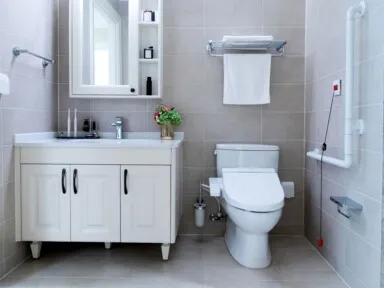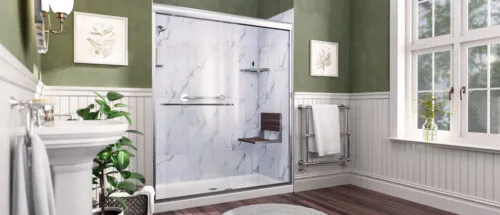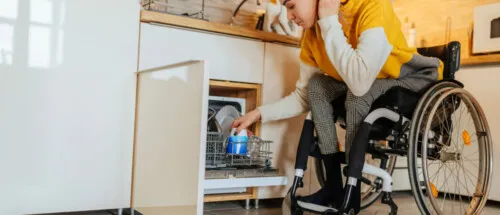Creating an accessible bathroom design or making home safety upgrades is more than just a renovation — it’s about restoring dignity and independence for individuals with mobility challenges. We’ve spent years helping families and individuals transform their bathrooms into safer, more comfortable spaces that empower users to maintain their privacy and self-reliance.
Whether you’re supporting an aging family member, recovering from an injury, or planning for long-term accessibility, our expertise in handicap bathroom remodels ensures that your space isn’t just an ADA-compliant bathroom, but truly welcoming and functional.
In this article:
- Understanding the Importance of Accessible Bathrooms
- Key Features of an Accessible Bathroom
- Planning Your Handicap Bathroom Remodel
- Maintenance and Upkeep of Accessible Bathrooms
- A Lasting Investment in Safety and Comfort
- Frequently Asked Questions
Understanding the Importance of Accessible Bathrooms
Many individuals who are aging or living with disabilities are most likely to get injured while using the bathroom. Due to the fear and discomfort of receiving assistance, the bathroom becomes a place of danger and potential injury — but it doesn’t have to be this way.
Creating an accessible bathroom can help prolong life and health, making the restroom easier to use and leading to greater safety and increased independence. Your bathroom renovation doesn’t have to sacrifice style or elegance, as ADA standard compliance can be used to create a functional and desirable environment in multigenerational homes.
Key Features of an Accessible Bathroom
Universal Design transforms bathrooms into functional, safe, and comfortable spaces for everyone, regardless of age, mobility, or ability. Below, we’ll outline key areas to implement universal design elements in your bathroom layout.
Doorways and Floor Space
Creating an accessible bathroom begins with the entryway, where the bathroom door design is crucial for accommodation. Doorway considerations include:
Doorway Width
- Doors should be at least 32 inches wide to accommodate wheelchair users and walkers.
- Side-entry doors should be 36 inches wide to allow wheelchair turning.
Door Handles
- Fixtures must be operable with one hand.
- Avoid knobs requiring grasping and heavy rotation.
- Lever handles are recommended for individuals with motor or dexterity challenges.
- Handles should move easily up and down for maximum accessibility.
Shower/Bathtub
Creating a safe and accessible shower takes careful planning, and finding the right layout and fixtures helps ensure functionality and safety. A curbless shower is an important component of any handicap-accessible bathroom, providing smooth, easy access for those with mobility challenges.
Shower Layout
- Install walk-in showers or roll-in showers without curbs or floor barriers.
- Minimum dimensions are 5 feet wide by 3 feet deep to accommodate wheelchair-accessible bathroom needs.
- Ensure floor space is open and cleared for easy wheelchair maneuverability.
- Install sturdy grab bars to help prevent slipping and provide support.
- Position grab bars at strategic heights and locations for maximum assistance.
- Use bars with non-slip, easy-to-grip surfaces.
Shower Fixtures
- Use handheld shower spray units with 60-inch hoses that allow use from seated positions.
- Ensure controls are easy to reach and have lever handles.
- Opt for a pressure-balanced shower valve and shower head with thermostat control to prevent scalding from temperature fluctuations.
Sink
A thoughtfully designed sink transforms the ADA bathroom into a user-friendly space where individuals with mobility challenges can comfortably access it.
- Provide knee clearance of at least 29 inches for wheelchair access.
- Mount sink or faucet top at least 34 inches from the floor for easy use while seated.
- Ensure 30 inches by 48 inches of clear space in front of the sink for wheelchair approach.
- Install a towel bar 36 inches from the floor for easy reach.
Toilet
Toilets can be a site of significant injuries if not designed right. Here are a few ADA guidelines for creating a safer toilet:
- Install wall-mounted toilets no higher than 17 inches.
- Provide a 36-inch wide path with sufficient space for wheelchair transfer.
- Consider toilets with a bidet or bidet combo for enhanced usability.
- Modify existing toilets with toilet seat risers and padded arms for added support during sitting and standing.
Accessible Fixtures
Grab bars are important safety features that provide stability and support throughout the bathroom, dramatically reducing the risk of slips and falls. Grab bar placement and specifications are below.
Ensure bars can support at least 250 lbs and install them in key locations:
- Near toilet
- Inside and outside shower/tub
- Beside sink
- Adjacent to bathroom entry/exit
Mounting options include:
- Wall-secured bars
- Flip-down bars
- Floor-to-wall bars
- Tub-mounted bars
Safety Installations
Strategic installations can transform a bathroom from potentially hazardous to confidently navigable. Safety goes beyond grab bars — it’s about creating an environment that supports mobility and prevents accidents.
Non-slip surfaces:
- Use textured tiles or slatted wood trays.
- Avoid concrete flooring.
- Ensure flooring has sufficient grip when wet.
- Discontinue the use of loose bath mats.
Lighting and electrical considerations:
- Position light switches at accessible heights.
- Place electrical outlets to avoid stooping.
- Maximize natural lighting.
Planning Your Handicap Bathroom Remodel
There are many considerations when planning a remodel, from tailoring the design to the specific needs of the individual to finding the right professionals.
Assessing Individual Needs
To make your bathroom more mobility-friendly and functional for someone with disabilities, it’s important to start with a comprehensive assessment of their specific needs. This will help you pinpoint exactly what modifications are necessary.
For more guidance, working with an occupational therapist can provide a detailed plan and recommendations tailored to the user’s needs. For example, this could include installing a grab bar at a specific height that’s best for the user’s reach and comfort. To learn more, consider exploring home trends for Baby Boomers.
Budgeting and Costs
After a thorough assessment, you’ll have a clearer idea of which bathroom modifications are essential and which might be optional or could wait for future updates. By prioritizing adjustments based on need, you can set a baseline budget, which typically ranges from $5,000 to $50,000.
We also recommend looking into federal, state, and local grants for accessibility home renovation, which can help ease costs where possible.
Hiring Professionals
Hiring the right professionals is crucial for creating a lasting, functional bathroom. Choose contractors with certifications in Aging-in-Place Specialization (CAPS) remodeling services who have experience designing safe environments. Before hiring a contractor, verify their credentials and ask for examples of previous accessible projects.
Maintenance and Upkeep of Accessible Bathrooms
The long-term safety and functionality of an ADA-compliant bathroom rely on regular maintenance to prevent accidents and ensure everything stays in top condition.
Regular Safety Checks
Check the safety of the space every few months by inspecting grab bars and fixtures to ensure they’re secure and functioning properly. Double-check non-slip surfaces by testing them with a wet cloth or checking for any wear and tear. Finally, inspect any modifications you’ve made, like light fixtures and door handles, to make sure they’re still working properly.
Adapting to Changing Needs
The mobility needs of a person can change over time, so the space must be able to adapt to those evolving needs. Designing the space to be adaptable and modular allows for quick adjustments, while other changes may require periodic assessments to evaluate mobility.
We also recommend staying informed about emerging accessibility technologies and home technology as we continue to learn more about creating safe, accessible spaces.
A Lasting Investment in Safety and Comfort
An accessible bathroom remodel is an investment in safety, independence, and overall quality of life for yourself or a loved one. By understanding the key elements of an ADA-compliant bathroom and considering the unique needs of the individual, you can create a space that’s not only accommodating now but adaptable for a safer, more comfortable life for years to come.
Frequently Asked Questions
What are some bathroom styles for disabled people?
Accessibility doesn’t mean sacrificing style. In fact, certain design styles are particularly well-suited for ADA-compliant bathrooms. Modern minimalist designs, with their wide open spaces and neutral colors, are perfect for accommodating wheelchair accessible spaces. Spa-inspired designs often feature calming neutral tones and natural-looking materials, which can be made slip-resistant for added safety. Industrial chic styles also work well, favoring open layouts and durable materials that make functional elements like metal grab bars an attractive part of the aesthetic.
What is a realistic budget for a bathroom remodel?
Many factors play a role when budgeting for a handicap bathroom remodel, especially the specific needs of the individual. That said, basic accessibility upgrades may range from $3,000 to $10,000, a full handicap-accessible remodel can run between $15,000 and $30,000, and a high-end custom accessible bathroom could range from $30,000 to $50,000.
Can I deduct the cost to renovate the bathroom to make it handicap accessible for elderly homeowner?
Yes, a medical expense tax deduction may be possible if the upgrades are medically necessary. Additionally, improvements that increase the home’s value may qualify for tax credits. To determine eligibility for aging-in-place bathroom modifications, it’s best to consult a tax professional in your area.
What features should be included in a handicap bathroom remodel?
Some key features to include in a handicap bathroom remodel include a walk-in or roll-in shower with grab bars, a raised toilet with side rails, non-slip flooring, and wide doorways. Adjustable-height sinks and mirrors are also important. Additionally, easy-to-use light switches and door handles, along with good natural lighting make a big difference.
Will Medicare pay for a handicap bathroom?
Medicare typically does not cover home modifications, but some Medicare Advantage plans may offer limited home adaptation benefits. In certain circumstances, Medicaid might provide partial coverage.



